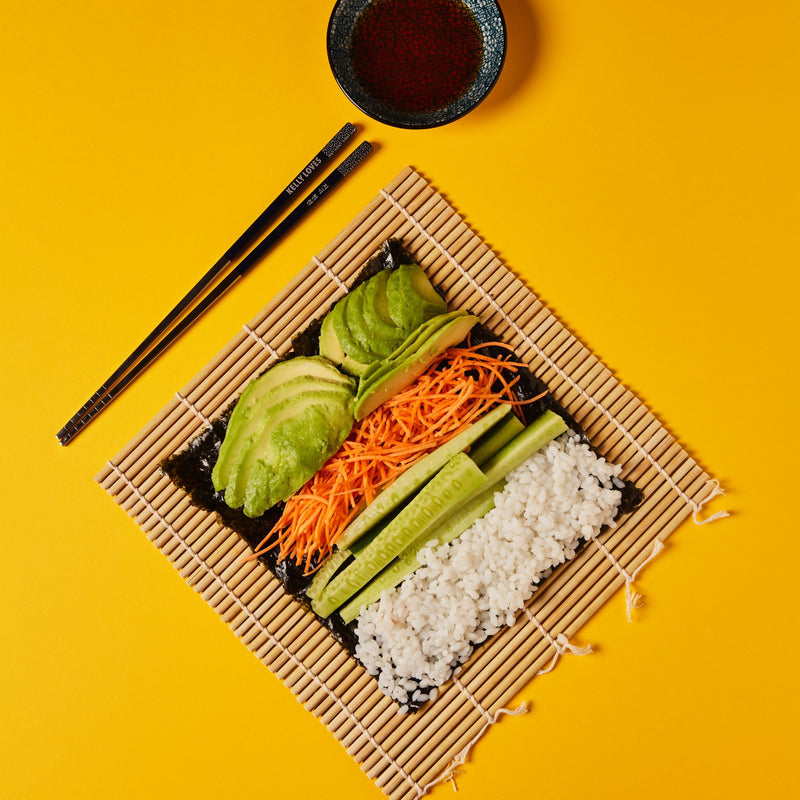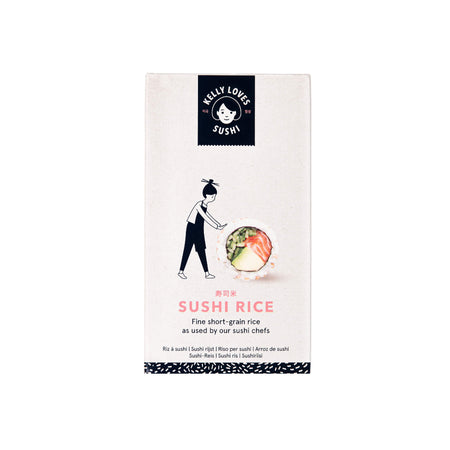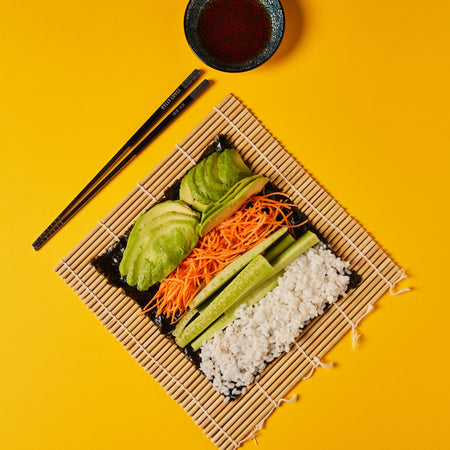Ingredients for sushi: a guide to homemade sushi

Making your own sushi is more cost-effective than visiting a restaurant, not to mention more fun. But when making sushi at home for the first time, the sushi ingredients themselves can be intimidating: raw fish, sheets of nori, sushi rice… Likewise, putting the ingredients together seems daunting. Especially if you think you’ll be all fingers and thumbs if you’re not ‘a crafty person’.
Let us reassure you that it’s easy once you know how; you’ll soon be rolling sushi routinely. A good place to start is with our sushi starter kit. The essential ingredients in this kit – sushi rice, nori sheets and rice vinegar – are non-perishables, so they can be stored in your cupboard for a while (useful if you like to stock up!).
Read on as we run through all the ingredients for sushi and the handy tools that can help you make the most authentic sushi at home with friends and family.
What ingredients do I need for sushi?
Sheets of dried nori (seaweed)
One of the key sushi ingredients, sheets of dried nori are essential for making sushi rolls. Nori is made from an edible seaweed called laver which is cultivated in estuaries in Japan. It’s green and reddish-purple in colour but turns black when dried. Nori is savoury to taste with a rich umami flavour.
You’ll soon be feeling rather sophisticated to have this stocked in your cupboard and it’s also very nutritious. As well as sushi rolls, you can add it to soup or salads for depth of flavour.
Sushi rice
Sushi rice is special. It’s made by cooking Japanese short-grain rice, which is then seasoned with a mixture of rice vinegar, salt, sugar and often kelp. This gives the sushi rice its stickiness and means that it’s perfect for moulding dainty little sushi mounds and sushi rolls.
It’s so delicious that you probably won’t just use it for sushi. You can also use it for other Japanese dishes or as a side dish for a meal — it even tastes good by itself. When preparing sushi rice, use a wooden bowl and spoon; metal spoons can react to the vinegar and damage the soft grains.
Seasoned vinegar for sushi rice
Japanese seasoned rice vinegar is the key ingredient when creating sushi rice. They say that the Japanese stopped using fermented rice between the 1300s and 1500s and added vinegar to the rice as a preservative. But the vinegar actually made the rice taste even better and when they added fish, it evolved to the delectable sushi we eat today.
Wasabi paste
For an added kick that can get quite addictive, wasabi is a punchy little condiment. Add a touch to sushi and sashimi to draw out subtle fish flavours. You can also mix it up in marinades, salad dressings or rice and noodle dishes – to add some spice. Our easy-to-use wasabi tubes mean less mess and less waste.
Pickled sushi ginger
Traditionally, sushi ginger is enjoyed in between sushi courses to cleanse the palate. Some people add ginger to the sushi. It’s totally up to you! Ginger lovers will relish the warming taste.
Sushi-grade raw fish
Sushi-grade raw fish usually comes in small blocks which you slice very thinly into sashimi slices with an extremely sharp knife. If you’re using sushi ingredients, including raw fish, for the first time, tuna is a good choice to start with.
Soy sauce
Soy sauce and sushi go hand in hand. Pour a little soy sauce in the dipping bowl and dip your freshly made sushi. But the key is not to over-dip, otherwise you’ll ruin the balance of flavours.
A sushi newbie might automatically think it best to dip the rice side into the dish, because that’s the most absorbent, but this is actually not the done thing. You dip the fish side or the nori side and only lightly.
What are the best fillings for your sushi?
With so many sushi combinations to try, you’ll never get bored! Here are some of our favourite fillings if you’re looking for some inspiration:
Protein:
- Prawns (cooked)
- Tuna (raw or cooked)
- Salmon
- Tofu
- Seafood sticks
Vegetables:
- Carrots
- Cucumber
- Sweet potato
- Bell peppers
- Avocado
- Jalapeño
- Lettuce
- Red onion
- Asparagus
To add some extra gooeyness: try guacamole or cream cheese fillings. For toppings, fried onions or black sesame seeds work well.
And how about fruit fillings? It can be so pretty and such a fun dessert. Mango, strawberry, kiwi and pineapple are our favourites!
What tools do I need to make sushi?
It doesn't take many tools to make sushi – it’s pretty straightforward (see, we told you it was easy). Here they are:
- Sushi rolling mat
- Dipping dishes for wasabi and soy sauce
- Chopsticks (only if you prefer, because sushi rolls, for example, are designed to be eaten using your fingers)
- A sharp knife
- Rice spreader or spatula
- A wooden spoon and bowl to handle the rice
When it’s your first time eating sushi in a restaurant, it can be hard to identify all the different ingredients and flavours. We hope we have demystified some of the sushi ingredients for you and that you’ll be encouraged to give homemade sushi a try! Lay out all the ingredients and let your family and friends choose their favourites. If it’s your guests’ first time making sushi too, you can use this blog post to explain a little about each ingredient.









